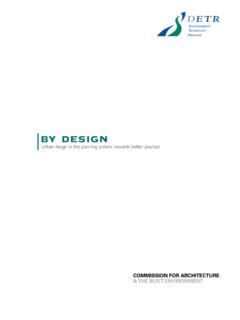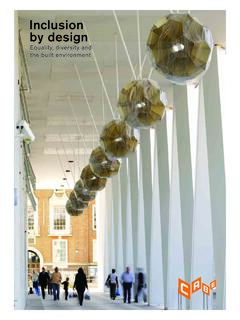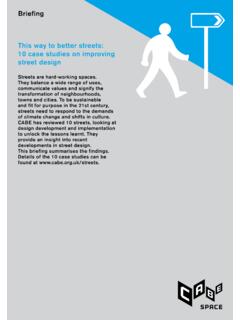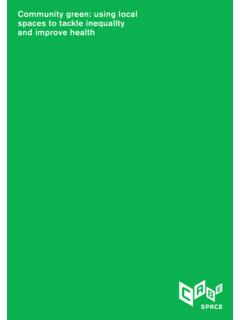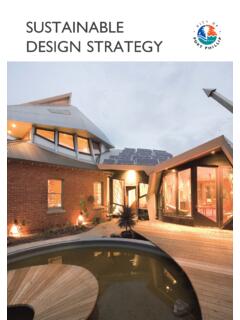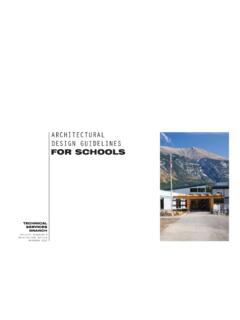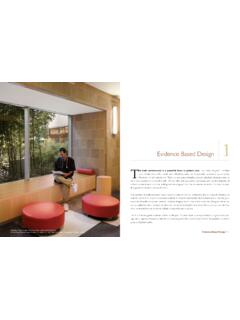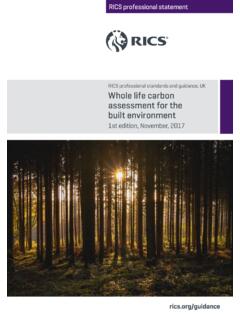Transcription of Inclusion by design
1 Inclusion by designEquality, diversity andthe built environment5642_A4:Layout 1 20/11/08 10:43 Page 1 Published in 2008 by theCommission for Architecture and the built is the government s advisor on architecture, urban design andpublic space. As a public body, we encourage policymakers to create places that work for help local planners apply nationaldesign policy and advise developersand architects, persuading them to put people s needs first. We show public sector clients how tocommission projects that meet theneeds of their users.
2 And we seek to inspire the public to demand morefrom their buildings and , influencing and inspiring,we work to create well-designed,welcoming places. Cover photo: Barking Town Centre, Tim SoarPrinted by Seacourt Ltd on Reviverecycled paper, using the waterlessoffset printing process (0 per centwater and 0 per cent isopropylalcohol or harmful substitutes), 100 per cent renewable energy andvegetable oil-based inks. SeacourtLtd holds EMAS and ISO 14001environmental rights reserved. No part of this publication may be reproduced,stored in a retrieval system, copied or transmitted without the priorwritten consent of the publisherexcept that the material may bephotocopied for non-commercialpurposes without permission from the document is available inalternative formats on requestfrom the :Layout 1 21/11/08 09:30 Page 2 Inclusion by designThe quality of buildings and spaces has astrong influence on the quality of people slives.
3 Decisions about the design , planningand management of places can enhance or restrict a sense of belonging. They canincrease or reduce feelings ofsecurity,stretch or limit boundaries, promote orreduce mobility, and improve or damagehealth. They can removereal and imaginedbarriersbetween communities and fosterunderstanding and generosity of spirit. Even though accessibility has improvedover the last decade, and planning policyhas shifted, with investment providing newfacilities to once-excludedcommunities, thefact remains that poor and disadvantagedpeople are far more likely to live in poorquality environments.
4 Social , cultural andeconomic inequalities are still being literallybuilt into new places, and planners anddesigners need to examine more closely theimpact of their :Layout 1 20/11/08 10:43 Page 3 People experience the builtenvironment differently according towho they are their social, culturaland economic background. The fulldiversity of this experience needs tobe considered if all users are to becomfortable and feel that a particularspace or place belongs to this briefing, we feature commentsfrom four different perspectives the Women s design Service,GALOP, the Stephen LawrenceCharitable Trust and from a mentalhealth consultant that vividlyillustrate what this long as women earn onaverage half of what men do, formthe majority of carers for elderlyrelations and still do most of thehousework and shopping.
5 There isa whole range of issues related toplanning, transport, urban design ,and housing provision which willimpact differently on the sexes. So long as women continue to be victims of sexual harassment,domestic violence and rape theywill have a radically differentexperience of what constitutessafety in homes, towns and publicspaces. Women live longer thanmen, which has consequences forpoverty in older age, disability andfrailty, loneliness and , in turn, has implications forthe design of lifetime homes DavisWomen s design access to inclusionFor me or not for me?
6 Why people experiencethe same place differentlyThe built environment can contribute to a more equal, inclusiveand cohesive society if the placeswhere we live, the facilities we use and our neighbourhoods andmeeting places are designed to be accessible and this briefing we look at a broadmeaning of Inclusion not justaccess starting with what aninhospitable built environment looks and feels like, and theunintended social, cultural andeconomic inequalities that able to live well in my home environment is essential to my mental and physical well-being.
7 Yet those of us most at risk of a breakdown in our mental health and well-being are much more likely to live insqualid housing amid constantnoise, and in an environmentwhere we are subjected toharassment and abuse. Quiet,books, natural beauty, green, open space these are allessential for me. It s not just about the environments we buildbut also about how we inhabitthem with kindness, goodmanners and a real respect foreach Klein Mental health service user and consultant 5642_A4:Layout 1 20/11/08 10:43 Page 4 Vauxhall Cross bus interchange Raf Makda/VIEWV auxhall Cross interchange:a central bus station withpedestrian movement broughtinto a single, simplified area at one of London s busiestjunctions.
8 Wide footpaths andsurface finishes help visuallyimpaired people and wheelchairusers. Better lighting and CCTV have improved security5642_210x210:Layout 1 20/11/08 10:43 Page 1 Getting aroundGetting around is about much more thanaccessible buses and trains. It is as important tohave well-designed and well-managed streets thatdon t act as a barrier to design means designing for transportthat is dignified, accessible, affordable, safe andeasy to use. It means:a chill-proof sheltera shelter with secure seatinga shelter with a talking countdown systema shelter with an emergency phonea safe and comfortable place to waita bus with a rampa bus that is safe from crime at nighta neighbourhood that works for people regardless of their transport design creates an way for everyone to get :Layout 1 21/11/08 10:34 Page 22 The management and use of a place1 The location anddesign of a placeThe location and design of placeshave a profound effect on howpeople benefit from them.
9 The issueshere are about about technical,geographical and physical access,and usability. The location and design of a place,its facilities, and equipment insidemay fail to take into account minoritycultural or religious requirementssuch as space for prayer andwashing facilities or numbers ofrooms. The impact of bad design is more likely to be felt by disabledpeople and older people, people from minority cultures and faiths,carers with young children, andtherefore has a disproportionateeffect on women. There is aconsiderable amount of research and good practice advice aboutdesigning environments that are often results frominvestment decisions made at a local, regional or even national decentralisation of healthcareservices, for instance, is verywelcome but the quality of publictransport links to the new helathcentres can still have an impact on how easy they are to use forpeople without a physical and technical access to a place and its usability do remainvital design issues.
10 Despite advancesin anti-discrimination legislation,policy and best practice guidance,many buildings are, beyond theirentrances, still difficult for disabledpeople to use with dignity and ease. The management and use of placeshave a significant effect on whetherwe find them friendly and welcoming,and whether they generate a senseof belonging. This idea is more subjective and less well researched, but not withoutplenty of anecdotal evidence. The ambiance of a place a combination of its design ,management, and use is more likely to have an impact on groupsthat experience exclusion in otherwalks of life, such as lesbians andgay men, women, disabled people,people from minority religions andcultures and from deprived socialbackgrounds.

